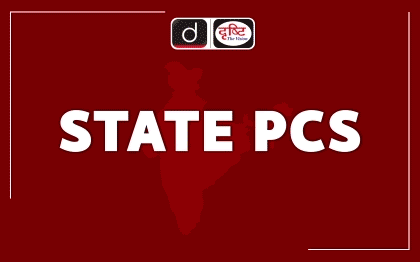Haryana Switch to Hindi
Pagri Sambhal Jatta Movement
Why in News?
On 23rd February 2025, farmers protesting at the Punjab and Haryana borders observed the Pagri Sambhal Diwas to honor Ajit Singh, the paternal uncle of freedom fighter Bhagat Singh.
Key Points
- About Ajit Singh:
- Birth and Early Life: Ajit Singh was born on February 23, 1881, in Khatkar Kalan village, Punjab (now part of Shaheed Bhagat Singh Nagar district).
- Freedom Fighter and Revolutionary: He was a prominent nationalist leader and played a key role in inspiring his nephew, Bhagat Singh.
- Exile and Struggle: Due to his role in the Pagri Sambhal Jatta movement, the British targeted him, forcing him into exile from 1909 to 1947.
- Return and Death: He returned to India in March 1947 but succumbed to ill health on August 15, 1947, in Dalhousie, coinciding with India's independence.
- The Pagri Sambhal Jatta Movement:
- Initiation and Meaning: Ajit Singh launched the movement in 1907 to protest against three oppressive agricultural laws imposed by the British.
- The phrase "Pagri Sambhal Jatta" means "Take care of your turban, O farmer", symbolizing self-respect and honor.
- Oppressive Laws:
- Punjab Land Alienation Act, 1900 – Restricted farmers' rights to sell or mortgage land, benefiting landlords and moneylenders.
- Punjab Land Colonisation Act, 1906 – Transferred land ownership to the British instead of farmers’ heirs in the Chenab Colony (now in Pakistan).
- Doab Bari Act, 1907 – Stripped farmers of land ownership rights, reducing them to contract laborers.
- Additional Burdens: The British also increased taxes on agricultural land and irrigation water, leading to widespread debt and land loss among small farmers.
- Impact of the Movement:
- Mass Protests: The movement led to large-scale farmer protests demanding the repeal of unjust laws.
- Formation of Bharat Mata Society: Ajit Singh and Kishan Singh (Bhagat Singh’s father) founded the Bharat Mata Society, a revolutionary group supporting farmers.
- Slogan: Nationalist poet Banke Dayal coined the slogan "Pagri Sambhal Jatta," which became a symbol of defiance.
- British Response: The British withdrew some oppressive clauses due to rising pressure.
- Influence on Future Movements: The movement laid the foundation for future uprisings, inspiring the Ghadar Movement and Bhagat Singh’s revolutionary activities.
- Arrests and Exile: In May 1907, Ajit Singh and Lala Lajpat Rai were arrested and exiled to Burma (now Myanmar) but were released in November 1907 under public pressure.
- Ajit Singh later fled to Persia, Turkey, Brazil, Germany, and Italy, working with revolutionaries like Lala Hardayal and Madame Cama.
- Pagri Sambhal Diwas:
- Observance Since 2021: Farmers have been observing February 23 as Pagri Sambhal Diwas since 2021, coinciding with Ajit Singh’s birth anniversary.
- 2021 Farmer Protests: During the Delhi border protests, farmers marked Pagri Sambhal Diwas while demanding the repeal of the three farm laws (now scrapped).
- 2024 Protests: Since February 13, 2024, farmers have been protesting at Punjab and Haryana borders, demanding Minimum Support Price as a legal guarantee and other rights.
Jharkhand Switch to Hindi
Review of Mega Infrastructure Projects
Why in News?
The Department for Promotion of Industry and Internal Trade (DPIIT) secretary led a high-level meeting to review key issues affecting mega infrastructure projects in Arunachal Pradesh, Sikkim, Delhi, and Jharkhand.
Key Points
- Review of Key Infrastructure Projects:
- The meeting reviewed 21 issues across 17 significant projects, including 9 projects under the Ministry of Road Transport and Highways.
- The total cost of all projects exceeded Rs 13,501 crore.
- The Varanasi-Ranchi-Kolkata Expressway project, valued at Rs 9,623.72 crore, was a major focus. This project involved seven issues across six packages.
- Focus on New NITs in Strategic Locations:
- The meeting emphasized the government's plan to establish new National Institutes of Technology (NITs) in strategic locations.
- These NITs aim to bridge regional disparities in technical education and meet the rising demand for skilled engineers and technical professionals.
- Beyond academics, these institutions will drive regional economic growth by fostering innovation, research, and industry collaboration.
- Varanasi-Ranchi-Kolkata Expressway Project:
- This expressway is a key project under the Bharat Mala Yojana, enhancing regional connectivity across Uttar Pradesh, Bihar, Jharkhand, and West Bengal.
- It is expected to boost trade and freight movement, benefiting industries that rely on the Kolkata and Haldia ports for maritime trade.
- Commitment to Efficient Project Monitoring:
- The Secretary reaffirmed the government’s commitment to strengthening the institutional framework for project monitoring.
- He directed authorities to adopt a proactive approach in resolving pending project issues.
- He urged private proponents to utilize the Project Monitoring Group (PMG) mechanism (PMG Portal) for expedited project implementation.
- The PMG mechanism ensures efficient and timely resolution of concerns through collaboration among the Central Government, State Authorities, and Private Stakeholders.
The Department for Promotion of Industry and Internal Trade (DPIIT)
- About:
- It was established in 1995 and was reconstituted in 2000 with the merger of the Department of Industrial Development.
- It was earlier called Department of Industrial Policy & Promotion; and was renamed DPIIT in 2019.
- In 2018, the matters related to e-Commerce were transferred to the Department and in 2019, the Department was given charge for matters related to internal trade, welfare of traders and their employees and startups.
- Objective:
- Reduce the compliance burden, simplify further the citizen-government interface whether online or offline, and remove antiquated and obsolete acts which don’t add value.
- To boost manufacturing and make Indian industry competitive, there are issues of quality and manufacturing of scale but the compliance burden is a major cost.
Chhattisgarh Switch to Hindi
End of Naxalism
Why in News?
Chhattisgarh Governor Ramen Deka declared that Naxalism in the state is on the verge of extinction.
Key Points
- Government’s Strategy to Eradicate Maoism:
- Addressing the Chhattisgarh Assembly on the first day of the Budget session, the Governor asserted that Naxalism is nearing its end in Chhattisgarh due to the government's strategic approach, the bravery of security forces, and public support.
- The government has intensified area domination efforts, leading to the elimination of over 300 Naxalites in the past 14 months.
- Additionally, 972 Naxalites have surrendered, while security forces have arrested 1,183 militants.
- Milestones in Naxal-Affected Regions:
- For the first time, flag-hoisting ceremonies were held in 26 Maoist-affected villages.
- Several villages, including Pentachimali, Keralapenda, Duled, Sunnam Guda, and Puvarti in Sukma, participated in the three-tier panchayat elections for the first time.
- After 19 years, a health center resumed operations in Potali village, Dantewada district.
- Other Developmental Measures:
- The Governor’s 59-point address included key initiatives such as:
- Implementation of a housing scheme for the poor.
- Expansion of forest produce collection programs.
- Promotion of industrialization to boost economic growth.
- The Governor’s 59-point address included key initiatives such as:
Naxalism
- Origin:
- The term Naxalism derives its name from the village Naxalbari of West Bengal.
- It originated as rebellion against local landlords who bashed a peasant over a land dispute.
- The movement soon spread across Eastern India in less developed areas of states such as Chhattisgarh, Odisha and Andhra Pradesh.
- Left-wing extremists (LWE) are popularly known as Maoists worldwide and as Naxalites in India.
- Objective:
- They advocate for the overthrow of the Indian government through armed revolution and the establishment of a communist state based on Maoist principles.
- They view the state as oppressive, exploitative, and serving the interests of the ruling elite, and seek to address socio-economic grievances through armed struggle and people's war.
Uttar Pradesh Switch to Hindi
Solar Dehydration Technology
Why in News?
Indian Institute of Technology (IIT) Kanpur has developed a new Solar Dehydration Technology, with the aim of increasing the income of farmers and reducing crop wastage.
Key Points
- Objective :
- This technology facilitates drying of fruits and vegetables through solar energy . It is an efficient and sustainable method.
- Its objective is to increase the income of farmers and reduce crop wastage .
- Farmers can preserve their crops for a long time using this technology and sell them when they get a fair price.
- Benefits :
- Solar dehydration is an eco-friendly method that saves energy and has a positive impact on the environment.
- Using solar energy reduces the need for conventional energy sources, thereby conserving natural resources.
- TRAINING PROGRAMS :
- Under this initiative, 30 farmers have recently been trained in solar dehydration technology.
- They were given a live demonstration of pre-treatment and solar drying of tomatoes, so that they can apply this technology in their farming.
- Collaboration:
- National Bank for Agriculture and Rural Development (NABARD) has played a crucial role in this project.
- Additionally, in partnership with the Food Processing Department of CSJM University, it has developed Standard Operating Procedures (SOPs) and quality protocols for this technology.
National Bank for Agriculture and Rural Development (NABARD)
- NABARD is an apex bank for agriculture and rural development.
- It was established on July 12, 1982 by an Act of Parliament based on the recommendations of the Sivaraman Committee.
- Its function is to provide credit flow for the promotion and development of agriculture, small industries, cottage and rural industries, handicrafts and other rural crafts.
- Along with this, the sustainable development of villages is to be done by providing support to other related economic activities in rural areas.
Uttar Pradesh Switch to Hindi
Ganga Water Purity
Why in News?
The Uttar Pradesh government issued a press release to clear the doubts about the purity of Ganga water in the Maha Kumbh 2025.
Key Points
- About the issue :
- Claim of purity of Ganga water :
- The press release was issued in reference to the data of the Central Pollution Control Board (CPCB) , in which doubts were raised over the quality of Ganga water in the Maha Kumbh .
- CPCB Report:
- The CPCB report had said that at the beginning of the Maha Kumbh, the Biological Oxygen Demand (BOD) of water at Sangam was 3.94 milligrams per litre.
- On 14th January, it was 2.28 mg per liter and on 15th January, it decreased to 1 mg per liter.
- However, on 24th January, the BOD increased to 4.08 mg per litre and on 29th January, it was recorded at 3.26 mg per litre.
- Research by Dr. Ajay Kumar Sonkar :
- Padmashree Dr. Ajay Kumar Sonkar dismissed doubts with scientific evidence to prove the purity of Ganga water.
- He collected water samples from various major bathing ghats of the Maha Kumbh and examined them microscopically.
- They found that despite millions of devotees taking bath in Ganga water, there was no growth of bacteria in it.
- No drop was observed in the pH level of water either.
- Claim of purity of Ganga water :
- Presence of natural viruses :
- Ganga water contains 1,100 types of natural viruses, called bacteriophages, that eliminate harmful bacteria.
Central Pollution Control Board (CPCB)
- The CPCB was constituted as a statutory organisation in September 1974 under the Water (Prevention and Control of Pollution) Act, 1974 .
- Thereafter, the Central Pollution Control Board was entrusted with powers and functions under the Air (Prevention and Control of Pollution) Act, 1981.
- The Board also provides technical services to the Ministry of Environment and Forests under the provisions of the Environment (Protection) Act, 1986 .
- The main functions of the Central Pollution Control Board are described under the Water (Prevention and Control of Pollution) Act, 1974 and the Air (Prevention and Control of Pollution) Act, 1981 .
Biological Oxygen Demand (BOD)
- The amount of oxygen required for the biochemical decomposition of organic matter in water is called BOD .
- The amount of water pollution is measured through BOD. But only biodegradable matter can be detected through BOD and it is a very long process. Hence BOD is not used in measuring pollution.
- It is noteworthy that high levels of BOD means that more oxygen is required to decompose large amounts of organic matter present in water.
Bihar Switch to Hindi
Development Projects Inaugurated in Nalanda
Why in News?
The Chief Minister of Bihar inaugurated and laid the foundation stone of a total of 263 development projects worth Rs 820.72 crore in Nalanda during his Pragati Yatra .
Key Points
- Major inaugurations and foundation stone laying
- These development projects include the inauguration of 177 projects worth Rs 361.66 crore and the laying of the foundation stone of 86 projects worth Rs 459.05 crore.
- The major projects are as follows:
- Inauguration of pond and library: During this, he inaugurated the pond, beautiful park and air-conditioned digital library built under the Amrit Sarovar Yojana in Naanand village of Silav block .
- Samajik Utthan Park : Constructed at a cost of Rs 19-22 lakh, instructions to keep it clean
- Pradhan Mantri Awas Yojana : Handed over newly constructed houses (with electricity, water and gardening facilities) to 12 Mahadalit families
- Providing financial support to Jeevika sisters.
- Rajgir Kund Complex : Inauguration of the newly constructed Yatri Vishram Bhawan
- Benar-Saksohra Road : Widening and Strengthening
- Fish Hatchery : Inspected
- Local playground : inspection, players provided with blazer balls and sports kits
- Interaction with beneficiaries of Samajik Bhavan, Work Shed and Child Welfare Scheme
- Future Projects
- Construction of Dinosaur Park in Rajgir
- Panchane Irrigation Scheme : Restoration and Development
- Establishment of Agricultural Research Center in Sarmera
Nalanda district
- Introduction:
- Nalanda is a major district of Bihar whose headquarters is Bihar Sharif . Its area is 2,355 square kilometers (909 sq mi).
- Historical Significance:
- Nalanda is world famous for its ancient history.
- The remains of the world's oldest Nalanda University are still located here.
- Buddha and Mahavira stayed at Nalanda several times.
- Mahavira attained salvation in Pavapuri (Nalanda) .
- Shariputra , the chief disciple of Buddha, was born in Nalanda .
- The famous Chinese traveller Hiuen Tsang spent a year here in the 7th century.
- Tourist Spots:
- Ruins of Nalanda University
- Nalanda Museum
- Hieun Tsang Memorial Hall
- Rajgir (Hot water springs – Brahmakund, Saraswati Kund, Langate Kund)
- Pavapuri (place of Mahavira's nirvana)
- Major rivers:
- Falgu
- Charm
Bihar Switch to Hindi
Printing of Counterfeit Indian Currency
Why in News?
On 21 February 2025, the Directorate of Revenue Intelligence (DRI) arrested seven modules involved in printing Fake Indian Currency Notes (FICN).
Key Points
- About the issue:
- Continuing its crackdown against modules involved in printing Fake Indian Currency Notes (FICN) and import of security papers, the Directorate of Revenue Intelligence (DRI) conducted simultaneous searches at 11 locations in Maharashtra, Haryana, Telangana, Tamil Nadu and Bihar .
- In this operation, seven modules active in printing FICN were arrested.
- Earlier also on February 8, 2025, the DRI had arrested two persons in Ghazipur and Bengaluru who were found to be importers of papers with embedded security thread bearing the words 'RBI' and 'India' ('Security Papers').
- The team seized fake currency notes of Rs 50 and Rs 100 denominations and several machinery/equipment.
- Impact:
- Damage to the economy
- The circulation of counterfeit currency could lead to inflation and economic instability .
- Mixing of real and fake currency can cause chaos in the banking system .
- Escalation of crime
- Fake notes are used for black money and illegal activities , which may lead to increase in terrorist activities.
- The trade of fake notes is linked to cross-border smuggling and other illegal activities
Directorate of Revenue Intelligence
- It is India's premier anti-smuggling intelligence, investigation and operations agency .
- Apart from this, this agency works to stop the smuggling of goods including drugs, gold, diamonds, electronics, foreign currency, and counterfeit Indian currency.
- The Directorate of Revenue Intelligence functions under the Central Board of Indirect Taxes and Customs in the Department of Revenue , Ministry of Finance , Government of India.
Bihar Switch to Hindi
Security Officers Appointed to Help Women
Why in News?
The Bihar government has decided to appoint 140 full-time 'protection officers ' in the state to provide more effective assistance to women affected by domestic violence .
Key Points
- About the issue:
- The Social Welfare Department has decided to create a separate cadre under which security officers will be appointed at the sub-division, district and state levels.
- Objective:
- To effectively deal with the rising cases of domestic violence.
- To provide protection to women from domestic violence and ensure protection of the rights granted to them by the Constitution.
- Level of placement:
- Security officers will be appointed at the sub-division, district, and state levels.
- A total of 140 security officers will be appointed :
- 101 at sub-division level
- 38 at district level
- 1 State Level Security Officer.
- Responsibilities of the Security Officer:
- To protect the rights of women under the Protection of Women from Domestic Violence Act, 2005 .
- To assist the Magistrate in his duties.
- To get the physical injuries of the victim, the woman medically examined and send the report to the concerned police station and magistrate.
- Ensuring compliance of economic relief orders under Section 20 of the Domestic Violence Act, 2005.
Domestic Violence Act, 2005
- Introduction:
- This is an important law to prevent domestic violence against women and provide them legal protection.
- Objective:
- The purpose of this Act is to protect women from violence in their homes or any other private place and to provide them protection of their rights.
- Different types of domestic violence:
- Physical violence:
- This includes physically hurting the woman.
- Example: Slapping, pushing, hitting, etc.
- Sexual violence:
- This includes misdeeds like sexual harassment or rape of a woman.
- Example: Forced intercourse, other sexual offences.
- Emotional abuse:
- This includes harming the woman’s mental state and self-esteem.
- Example: Insulting, betraying, intimidating, or making the woman feel mentally weak.
- Social and economic control:
- This includes isolating the woman from her family and friends, socially isolating her, or confining her against her will.
- Physical violence:




%20MPPCS%202025%20Desktop%20E.jpg)
%20MPPCS%202025%20Mobile%20E%20(1).jpg)










.png)
.png)











 PCS Parikshan
PCS Parikshan
.jpg)
.jpg)


